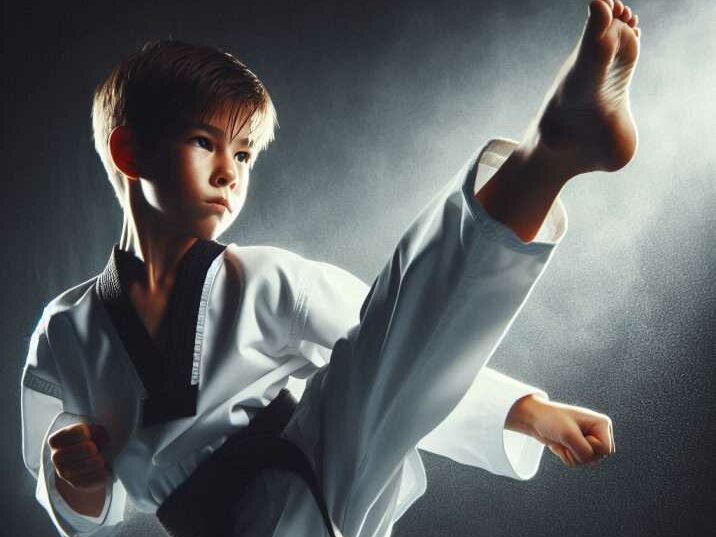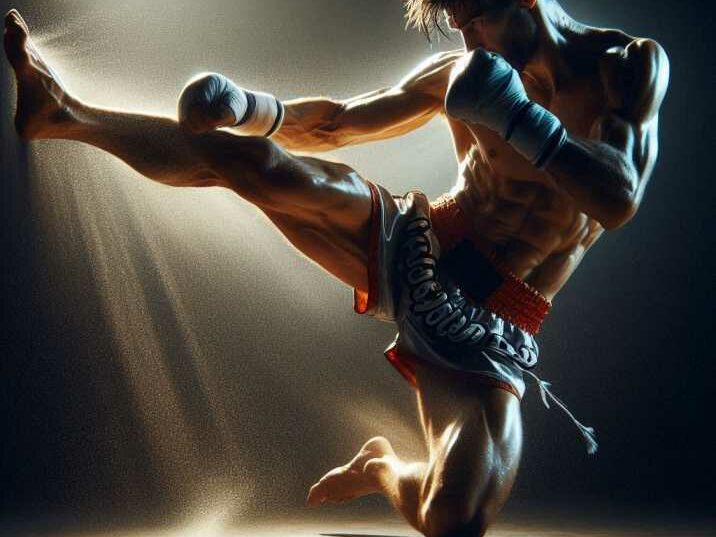Introduction
Table of Contents
Martial arts have been a significant part of human culture for centuries, offering more than just self-defense skills. They promote physical fitness, discipline, and mental toughness. Two popular martial arts, Taekwondo vs. Muay Thai, are renowned for their unique fighting styles and techniques. This article aims to compare and contrast the emphasis on kicking techniques in Taekwondo with Muay Thai’s use of eight limbs, providing an informative and engaging read for martial arts enthusiasts and beginners alike.
The Emphasis on Kicking Techniques in Taekwondo
What is Taekwondo?
Taekwondo is a Korean martial art that literally means “the way of the foot and hand.” It is characterized by its high, fast, and spinning kicks. Taekwondo practitioners, or taekwondoin, train extensively in a variety of kicking techniques, which form the core of their combat strategy.

Key Kicking Techniques
Roundhouse Kick (Dollyo Chagi)
The roundhouse kick is a fundamental technique in Taekwondo, known for its speed and power. It involves a rotational movement of the body to deliver a powerful strike with the top of the foot.
Side Kick (Yeop Chagi)
The side kick is a straight, powerful kick that targets an opponent’s midsection or head. It is effective for creating distance and delivering a strong blow.
Spinning Hook Kick (Dwi Huryeo Chagi)
The spinning hook kick is an advanced technique where the practitioner spins 360 degrees to deliver a hooking kick to the opponent’s head. It combines speed, precision, and power.
Additional Kicking Techniques
Axe Kick (Naeryo Chagi)
The axe kick involves lifting the leg high and bringing it down in a powerful, chopping motion. It can be aimed at an opponent’s head or shoulder.
Front Kick (Ap Chagi)
The front kick is a straightforward kick executed with the ball of the foot. It is often used to push an opponent away or to strike the midsection.
Training and Discipline
Taekwondo emphasizes discipline, respect, and continuous improvement. Practitioners perform Poomsae, or forms, which are a series of pre-arranged movements that include various kicking techniques. These forms help improve balance, coordination, and technique.
Muay Thai and the Art of Eight Limbs
What is Muay Thai?
Muay Thai, also known as “The Art of Eight Limbs,” is a martial art from Thailand. It is called the art of eight limbs because it utilizes punches, kicks, elbows, and knee strikes, making it a versatile and powerful combat sport.

Key Techniques in Muay Thai
Punches (Mat)
Muay Thai uses a variety of punches similar to those in Western boxing, including the jab, cross, hook, and uppercut.
Kicks (Te)
While Muay Thai includes powerful kicks, the focus is not as extensive as in Taekwondo. Common kicks include the roundhouse kick and the push kick (Teep).
Elbow Strikes (Sok)
Elbow strikes are a defining feature of Muay Thai. Techniques such as the horizontal elbow and uppercut elbow can cause significant damage to an opponent.
Knee Strikes (Ti Khao)
Knee strikes in Muay Thai are used both defensively and offensively. Techniques include the straight knee, diagonal knee, and jumping knee.
Additional Techniques
Clinching
The clinch is a close-range grappling technique used to control an opponent and set up strikes, particularly knees and elbows.
Sweeps and Throws
Muay Thai also incorporates sweeps and throws to unbalance and take down an opponent.
Training and Culture
Muay Thai training is intense and focuses on conditioning and endurance. Practitioners perform Wai Kru, a ceremonial dance that shows respect to their teachers and the sport. This tradition highlights the deep cultural roots of Muay Thai.
Comparing Taekwondo vs. Muay Thai: Kicking Techniques
Taekwondo
High Emphasis
Taekwondo places a strong emphasis on kicking techniques, which are considered the hallmark of this martial art. The kicks in Taekwondo are designed for speed, height, and agility. Practitioners spend a significant amount of time perfecting their kicks, aiming to achieve both power and precision. The high emphasis on kicks is due to the belief that the legs are more powerful than the arms and can deliver stronger, more effective strikes.
Variety
Taekwondo includes a wide variety of kicks, from basic to advanced, each serving a specific purpose in both offensive and defensive scenarios. Here are some of the most prominent kicks in Taekwondo:
- Front Kick (Ap Chagi): A straightforward kick executed with the ball of the foot, often used to push an opponent away or to strike the midsection.
- Roundhouse Kick (Dollyo Chagi): Known for its speed and power, this kick involves a rotational movement of the body to deliver a powerful strike with the top of the foot.
- Side Kick (Yeop Chagi): A straight, powerful kick targeting an opponent’s midsection or head. It is effective for creating distance and delivering a strong blow.
- Axe Kick (Naeryo Chagi): Involves lifting the leg high and bringing it down in a powerful, chopping motion aimed at the opponent’s head or shoulder.
- Spinning Hook Kick (Dwi Huryeo Chagi): An advanced technique where the practitioner spins 360 degrees to deliver a hooking kick to the opponent’s head, combining speed, precision, and power.
- Back Kick (Dwi Chagi): Executed by turning the body away from the opponent and delivering a powerful kick with the heel, often used as a counter-attack.
Muay Thai
Balanced Approach
Muay Thai, also known as “The Art of Eight Limbs,” adopts a more balanced approach to its techniques. While kicks are an essential part of Muay Thai, they are integrated into a broader set of techniques that include punches, elbows, and knee strikes. This balanced approach ensures that practitioners can adapt to various combat situations using a combination of strikes.
Power Focus
Muay Thai kicks are renowned for their power and effectiveness. The training focuses on developing strong, impactful kicks that can wear down an opponent. Here are some key kicks in Muay Thai:
- Roundhouse Kick (Te Chiang): This is the most commonly used kick in Muay Thai. It is delivered with the shin and is aimed at the opponent’s legs, ribs, or head. The roundhouse kick is known for its devastating power and can be used to weaken an opponent’s legs or body.
- Push Kick (Teep): Often referred to as the “foot jab,” this kick is used to push the opponent away, maintain distance, and disrupt their balance. It is executed by thrusting the ball of the foot into the opponent’s midsection or thigh.
- Low Kick (Te Chiang Khadok): This kick targets the opponent’s thigh, aiming to weaken their leg and reduce their mobility. The low kick is highly effective in wearing down an opponent over time.
- High Kick (Te Chiang Yud): Similar to the roundhouse kick but aimed at the opponent’s head. It requires flexibility and precision to execute correctly.
- Switch Kick: A deceptive kick that involves a quick switch of stance before delivering a powerful kick. This technique is used to catch the opponent off guard and land a surprising blow.
Training Methods for Kicking Techniques
Taekwondo
Training Methods: Taekwondo training includes a variety of drills and exercises to perfect kicking techniques. Practitioners use paddles, heavy bags, and kicking shields to practice and refine their kicks. Flexibility exercises and strength training are also integral parts of Taekwondo training to enhance kicking ability.
Forms (Poomsae): Practicing forms, or Poomsae, is a crucial aspect of Taekwondo training. These forms are a series of pre-arranged movements that include various kicking techniques. They help improve balance, coordination, and technique, ensuring that practitioners can execute kicks with precision and power.
Muay Thai
Training Methods: Muay Thai training is known for its intensity and focus on conditioning. Practitioners spend a significant amount of time on heavy bags, pads, and sparring to develop their kicking techniques. Heavy bag training helps build power and endurance, while pad work with a partner allows for precision and timing.
Conditioning: Muay Thai also emphasizes conditioning exercises, such as running, skipping, and strength training, to improve overall fitness and kicking power. These exercises help build the necessary strength and endurance to deliver powerful kicks consistently.
By understanding the differences in kicking techniques and training methods between Taekwondo and Muay Thai, practitioners can appreciate the unique aspects of each martial art and choose the one that best aligns with their goals and interests. Whether it’s the high, fast kicks of Taekwondo or the powerful, balanced approach of Muay Thai, both styles offer valuable skills and insights into the world of martial arts.
Use of Eight Limbs
Taekwondo
- Limited Use: Primarily uses kicks, with some hand strikes.
- Specialization: Focuses on mastering a narrower range of techniques for competitive sparring.
Muay Thai
- Comprehensive Use: Utilizes punches, kicks, elbows, and knees.
- Versatility: Emphasizes a well-rounded skill set that can adapt to various combat situations.
Training Regimens
Taekwondo
- Structured: Training often includes practicing forms, sparring, and drills focused on agility and technique.
- Discipline: Strong focus on discipline, respect, and mental development.
Muay Thai
- Intense Conditioning: Training is physically demanding, with a focus on endurance, strength, and practical fighting skills.
- Cultural Traditions: Incorporates traditional rituals and respect for the sport’s heritage.
Competition and Rules
Taekwondo
- Olympic Sport: Taekwondo is an official Olympic sport with strict rules focusing on points scored through accurate and controlled techniques.
- Protective Gear: Competitors wear protective gear, including headgear and chest protectors, to minimize injury.
Muay Thai
- Professional Fights: Muay Thai is known for its professional fighting scene, with matches that can end in knockouts or decisions.
- Minimal Gear: Fighters typically wear gloves and shorts, with minimal protective gear, emphasizing toughness and resilience.
Health Benefits
Taekwondo
- Cardiovascular Fitness: High-intensity kicking techniques improve cardiovascular health.
- Flexibility and Agility: Regular practice enhances flexibility, balance, and agility.
Muay Thai
- Strength and Endurance: Intense training routines build muscular strength and endurance.
- Coordination: The use of eight limbs improves overall coordination and body control.
Mental Benefits
Taekwondo
- Focus and Discipline: Emphasizes mental discipline, respect, and self-control.
- Goal Setting: Progress through belt ranks encourages goal setting and achievement.
Muay Thai
- Mental Toughness: Demands mental resilience and the ability to stay calm under pressure.
- Confidence: Builds confidence through rigorous training and competitive experience.
Table of Information about Taekwondo vs. Muay Thai
| Aspect | Taekwondo | Muay Thai |
|---|---|---|
| Origin | South Korea | Thailand |
| Main Techniques | Kicking | Punching, Kicking, Elbow, and Knee Strikes |
| Primary Focus | Speed and agility | Power and endurance |
| Competition Style | Points-based sparring | Knockout or decision-based fights |
| Training Equipment | Paddles, heavy bags, protective gear | Heavy bags, pads, ropes, rings |
| Cultural Significance | Strong emphasis on etiquette and forms (Poomsae) | Rich history with ceremonial dances (Wai Kru) |
Conclusion
Taekwondo and Muay Thai offer unique approaches to martial arts, each with its own strengths and techniques. Taekwondo’s emphasis on high, fast, and intricate kicks contrasts with Muay Thai’s powerful, versatile use of eight limbs. Whether you are drawn to the speed and agility of Taekwondo or the robust and comprehensive techniques of Muay Thai, both martial arts provide valuable skills and cultural insights.
FAQs
1. Which martial art is better for self-defense, Taekwondo vs. Muay Thai?
Both martial arts can be effective for self-defense. Taekwondo emphasizes quick, powerful kicks, while Muay Thai offers a broader range of techniques using all eight limbs.
2. Can kids learn both Taekwondo and Muay Thai?
Yes, both Taekwondo and Muay Thai are suitable for kids. They teach discipline, improve physical fitness, and build confidence.
3. How long does it take to become proficient in Taekwondo or Muay Thai?
Proficiency varies depending on the individual’s dedication and training frequency. Generally, it can take several years of consistent practice to become proficient in either martial art.
4. Are there competitions for Taekwondo vs. Muay Thai?
Yes, both martial arts have competitive scenes. Taekwondo is an Olympic sport with point-based sparring, while Muay Thai competitions focus on knockouts and decisions.
5. What equipment is needed for training in Taekwondo vs. Muay Thai?
Taekwondo training requires paddles, heavy bags, and protective gear. Muay Thai training involves heavy bags, pads, ropes, and often takes place in a ring.


